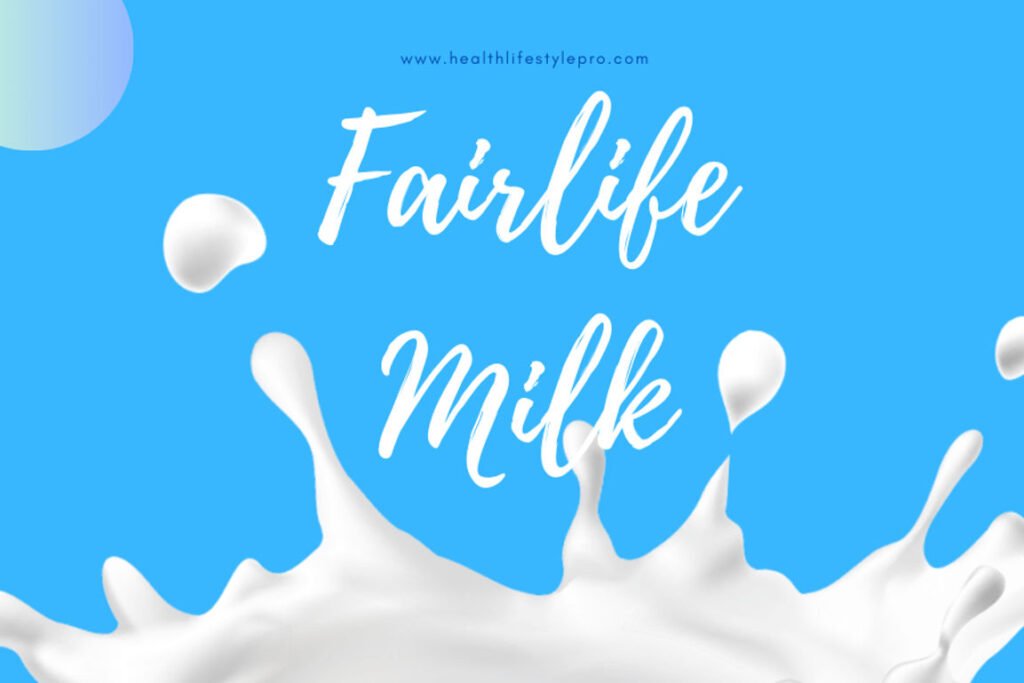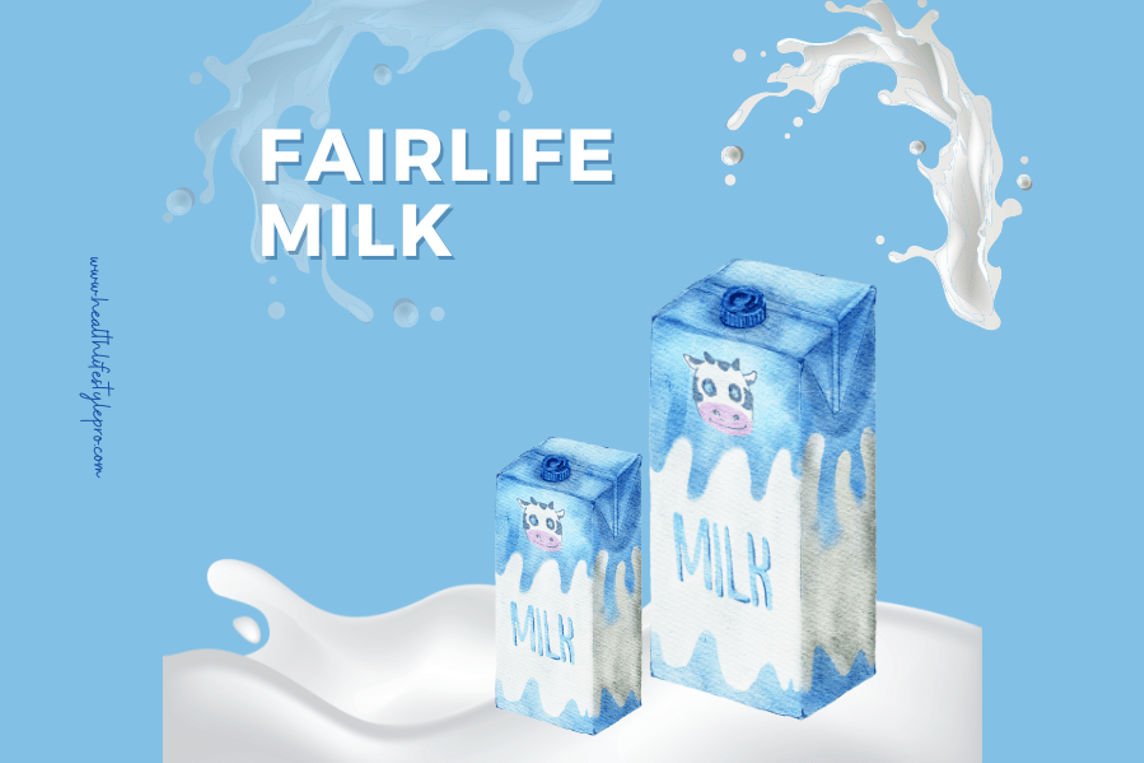As an innovative kind of dairy product, ultra-filtered milk is known by a different name than ordinary milk.
To make it, Now the question is Is Fairlife Milk Healthy? the U.S. Dairy Export Council says that a procedure known as ultrafiltration is used to separate the different components of milk based on their chemical compositions.
The process of filtering conventional cow’s milk separates the water and lactose from other components, changing the makeup of the milk. This is how ultra-filtered milk is made, according to certified dietitian Elysia Cartlidge, RD.

“As a result, the filtration process may make the milk higher in protein and lower in lactose.”
You can use ultra-filtered milk in your coffee and cereal just like you would regular milk because it tastes exactly like ordinary dairy milk (though the filtration process can occasionally make it a little thicker). It also adds a high-protein punch to shakes and smoothies.
Comparing Fairlife and Regular Milk
| Nutrient/Aspect | Fairlife Milk | Regular Milk |
|---|---|---|
| Protein Content | Higher protein content (per serving). | Typically contains a good source of protein. |
| Calcium | Enriched with calcium (may vary). | Naturally rich in calcium. |
| Fat Content | Generally lower fat content. | Fat content depends on the type (whole, 2%, skim). |
| Sugar Content | May have lower sugar content (flavored variants). | Contains lactose; sugar content varies. |
| Lactose | Potentially lower lactose content. | Contains lactose, which may be an issue for lactose-intolerant individuals. |
| Processing Method | Ultra-filtration process is used. | Traditional pasteurization process. |
| Additional Additives | May include additional fortifications (e.g., DHA Omega-3). | Generally free from additional fortifications. |
| Taste and Texture | Some consumers find a smoother texture and different taste. | Traditional taste and texture. |
| Cost | Tends to be more expensive than regular milk. | Generally more cost-effective. |
| Sustainability | Some concerns about the environmental impact of the ultra-filtration process. | Traditional milk production may have environmental considerations. |
Key Considerations:
- Protein: Fairlife Milk may provide a higher protein content, making it appealing for those prioritizing protein intake.
- Calcium: Both Fairlife Milk and regular milk are good sources of calcium, essential for bone health.
- Fat and Sugar: Fairlife Milk may have advantages in terms of lower fat and sugar content, especially in flavored variants. However, individual preferences and dietary goals play a role.
- Lactose: Fairlife Milk may be a suitable option for those with lactose intolerance due to potentially lower lactose content.
- Processing: Fairlife Milk undergoes ultra-filtration, while regular milk goes through traditional pasteurization. Some consumers prefer one method over the other.
- Additives: Fairlife Milk may contain additional fortifications, catering to specific nutritional needs.
- Cost and Sustainability: Fairlife Milk is often priced higher, and there may be considerations regarding the environmental impact of its production.
In conclusion, whether Fairlife Milk is a healthier option depends on individual health goals, dietary preferences, and tolerance levels. It’s advisable to review nutritional labels, consider personal preferences, and consult with healthcare professionals for personalized advice.
The Effects of Dairy-Free Milk on the Brain Are Surprising
Fortified with elements like calcium, which is essential for strong bones, milk substitutes including rice milk, coconut milk, almond milk, and soy milk are available. However, the World Health Organization (WHO) claims that iodine is essential for brain development, and they lack it (via The Independent).
Iodine levels in 47 non-dairy milk substitutes were compared to those in semi-skimmed cow’s milk by researchers from the University of Surrey, UK. According to their research, which was published in the British Journal of Nutrition, the iodine content of most of these milks was only 2% of what was found in cows’ milk.
As per the U.S. National Institutes of Health, the majority of adults require 150 mcg of iodine per day, which rises to 220 mcg during pregnancy. The NIH states that children and infants up to the age of 18 require a range of roughly 90 mcg to 150 mcg. Per The Independent, a UK study discovered that the amount of iodine in a glass of milk substitute is merely around 2 micrograms.
Foods high in iodine include dairy, seafood, and iodized salt
Low iodine can result in fibrocystic breast disease, which is not hazardous but causes lumpy, uncomfortable breasts in women of reproductive age and throughout menopause, in addition to stunted growth and intellectual deficits in newborns and early children (via the NIH). Infertility, obesity, heart disease, and joint pain are just a few of the health issues that can arise from hypothyroidism, or an underactive thyroid, which is another condition that low iodine levels can add to.
In the UK and other independent states, cow’s milk and other dairy products are the primary sources of iodine. However, iodine shortage is such a global health concern that it prompted the WHO to develop iodized salt. According to certified dietician Sarah Bath, a lecturer in public health nutrition at the University of Surrey, consumers who use dairy-free milk or milk substitutes should make sure they get enough iodine from other dietary sources (via The Independent). But she warned them not to eat kelp since it can contain too much iodine.
If you use salt in your cooking or other food preparation, use iodized salt rather than unfortified sea salt or other low-iodine options. Health experts state that iodine can also be found in eggs, shellfish, and other dairy items (via The Healthy).
Fairlife milk offers athletes extra protein
What is there to dislike about this premium milk, then? Price, to start with. According to Men’s Health, fairlife milk is around twice as expensive as conventional milk, which is a disadvantage for families who drink a lot of milk every week. Moreover, some experts doubt that most individuals need the extra nourishment that milk is touted to provide. “Milk is already a great package of nutrients; I’m not quite sure why it needs to be changed,” says registered dietitian Keri Gans. “When you look at the numbers, it can sound appealing, but in general most Americans are already getting enough protein,” adds nutritionist Alissa Rumsey (via New York Daily News). Then why would you fix something that isn’t damaged?
Certain families could truly benefit from Fairlife’s distinct nutritional profile, even though most families might not want to spend the extra money on ultra-filtered milk. Fairlife milk is likely to be a great addition to the diets of athletes recovering from hard exercises, people trying to increase their calcium intake (such as those at risk of osteoporosis), and, of course, those who cannot tolerate lactose.
Regular vs. Ultra-Filtered Milk
| Per 8 oz. | Regular 2% Milk | 2% Ultra-Filtered Milk |
|---|---|---|
| Calories | 120 | 120 |
| Total Fat | 5 g | 4.5 g |
| Saturated Fat | 3 g | 3 g |
| Total Carbs | 12 g | 6 g |
| Sugar | 12 g | 0 g |
| Protein | 8 g | 13 g |
| Calcium | 25% Daily Value (DV) | 30% DV |
| Vitamin D | 15% DV | 25% DV |
Advantages
Increased Protein, Calcium, and Vitamin D Content
The nutritional profile is a major benefit of ultra-filtered milk.
“Ultra-filtered milk still provides protein, carbohydrates, vitamins and minerals just like your regular dairy milk, however, some of the nutrient amounts differ,” according to Cartlidge.
“While regular milk and ultra-filtered milk are both nutrient-dense options, ultra-filtered milk does tend to have more calcium, vitamin D, protein, and less total carbs than regular milk.”
It’s Lacking of Gluten
As per the National Institutes of Health, around 68% of the global populace suffers from lactose malabsorption or intolerance. This happens when the lactose sugar in milk is not completely absorbed by the body, leading to adverse reactions including flatulence and diarrhea.
For people who are lactose intolerant, ultra-filtered milk is a fantastic alternative because it is typically lactose-free, tastes similar, and has a superior nutritional profile than ordinary milk.
It Has Less Sugar
Ultra-filtered milk has less sugar than regular milk since the lactose is removed during filtration. Recall that sugar is a sort of carbohydrate and that lactose is a type of sugar. This makes ultra-filtered milk an essential kitchen staple for those following a low-sugar or low-carb diet.
Disadvantages
It Costs More
Even though ultra-filtered milk initially looks like ordinary milk, it is regarded as a different product. The extra procedure known as ultrafiltration incurs additional expenditures for the manufacturer. Ultra-filtered milk is more costly than ordinary milk since these expenses are subsequently transferred to the customer.
Because it is less prevalent than conventional milk, there are fewer selections and it is not as widely available, which might lead to higher prices.
It Is Lactose-Free, Which May Be Health Benefiting
Lactose-tolerant individuals may benefit from this sugar in terms of health. Although most types of ultra-filtered milk are lactose-free, ordinary milk includes lactose.
A study published in Nutrition in November 2019 found that lactose is a preferred carb for babies and kids since it feeds their bodies and helps with intestinal health.
Although lactose is not a necessary food, children may benefit from it in terms of health. This ingredient is removed when you switch to ultra-filtered milk, although other dairy products can still contain lactose.
Is Fairlife Milk Healthier Than Regular Milk?
One of the most common questions is whether Fairlife Milk is a healthier option. The answer lies in understanding the nutritional profile. Fairlife Milk typically contains [mention specific advantages, e.g., higher protein or lower sugar]. However, it’s essential to consider individual dietary needs and preferences.
FAQs: Is Fairlife Milk Healthy?
- Is Fairlife Good or Bad for You?
Fairlife Milk has faced scrutiny regarding its processing method. Some argue that the ultra-filtration process removes impurities, resulting in a cleaner product. However, concerns have been raised about the impact of this process on the overall nutritional quality. - Is Fairlife Milk True Milk?
The filtration process raises questions about the authenticity of Fairlife Milk as “true” milk. While it undergoes a unique process, it still originates from cow’s milk. It’s essential to differentiate between processing methods and the source of the milk. - Is Fairlife Milk High in Sugar?
Concerns about sugar content are valid, considering the rise in health-conscious consumers. Fairlife Milk may have [mention specific sugar content], and it’s crucial for individuals monitoring their sugar intake to be aware of this factor.
Conclusion
In summary, Fairlife milk presents a straightforward and practical approach to incorporating more nutrients into your diet without overindulging in sweets. If you have any questions about your physical well-being, you can get in touch with a nutritionist

I’m a seasoned content creator with 6+ years of experience crafting engaging, SEO-optimized content that drives traffic and rankings. I excel in keyword research, link building, and guest posting, ensuring your brand reaches new heights.

